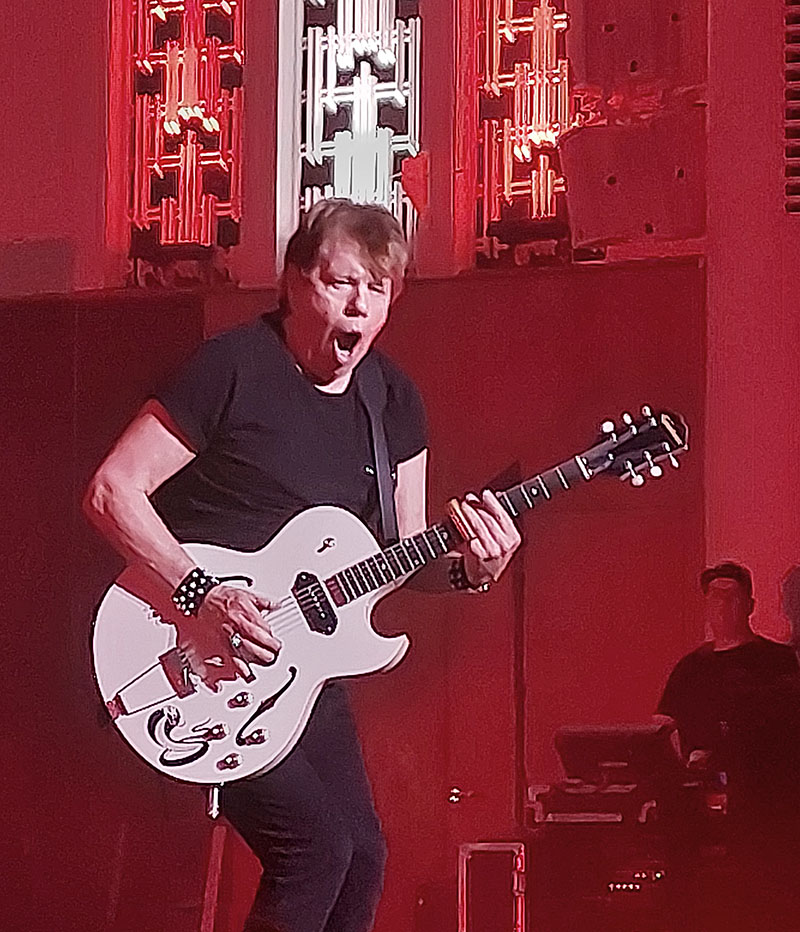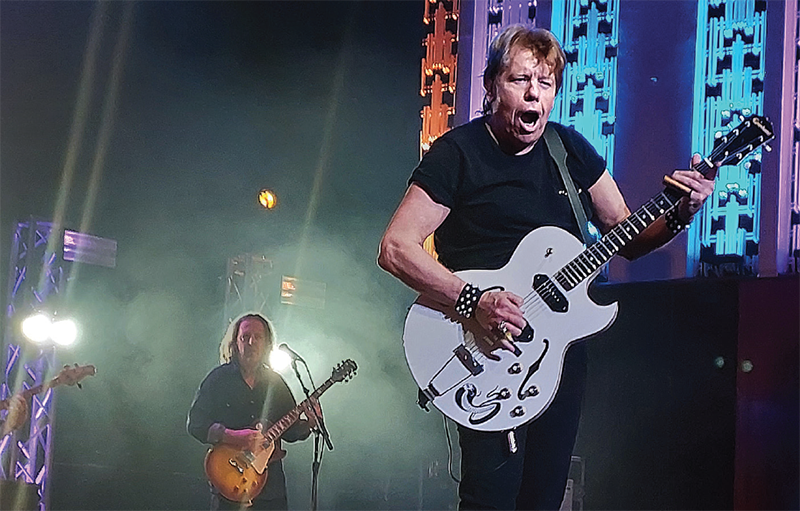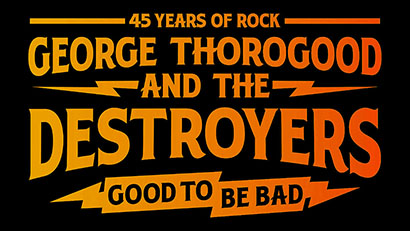George Thorogood ‘Good to Be Bad’ Tour
Originally published by Front of House Magazine
By Richard Starr

George Thorogood performs at the Liverpool Philharmonic Hall on the UK leg of his 2022 tour. Photo by Dark Dwarf
Veteran blues rocker George Thorogood is on the road with his band The Destroyers for performances across the U.S. and Europe that stretch from summer into fall, followed by a month of shows in Australia and New Zealand.
Known for songs like “Bad to the Bone,” “Get a Haircut” and “Born to Be Bad,” Thorogood and The Destroyers have sold more than 15 million records in their career. And even at 69 years, Thorogood himself is showing no signs of slowing down, with his well-earned reputation as a tireless live act, regularly delivering high-energy performances all over the globe for the past 45 years.
Thorogood is touring as a five-piece, joined by with longtime band members Jim Suhler (rhythm guitar), Jeff Simon (drums), Bill Blough (bass) and Buddy Leach on saxophone.
Supporting the tour is Nashville-based sound company 242 Concepts, Inc., who are providing all the audio gear, sometimes with full production and — depending on the venue / location — occassionally relying on house rigs, combined with their front-end, monitoring and FOH gear. When deploying full P.A., the band travels with 242 Concepts’ 32-box RCF HDL30a rig with 16 RCF 9006 subs and 48 RCF HDL26A speakers as front / side hangs and front fills. Consoles — both monitor and FOH —are all from Allen & Heath’s dLive platform.

FOH engineer Jeff Pitt mixing on the Allen & Heath dLive S5000 at the Paramount Arts Center, Ashland, KY
The FOH View
The front of house engineer — who also handles system engineer and production manager duties — is veteran Jeff Pitt of production company 242 Concepts. Pitt has now been mixing Thorogood for nearly a quarter century.
“I began touring in the 90s,” Pitt recalls. “I worked for a variety of country artists from BR549 to Carrie Underwood and everything in-between, although GT has been my only client for the last 15 years, which allows me to really focus on the details of this tour.” He also added that his relationship with Thorogood “began as a fill-in position for six weeks, and now 2023 will mark my 24th year with the band. This team of people has become my family. It’s been an incredible run!”
And according to Pitt, audio versatility — and the ability to be ready for anything is essential. “The old saying ‘No hall too small, no bar too far!’ still rings true today. I refer to this as the accordion tour. You have to be able to scale in an 800-seat club one day, a 2,000-seat theater the next, an arena on the next day, amphitheater the next and a huge festival over the weekend. It’s definitely not for the faint at heart and is full of unique challenges daily,” he explains. “George communicates with the audience very effectively and directly. He’ll be talking to the guy in the third row standing two feet away from the mic and it’s my job to ensure the fans understand every word he speaks.”
However, Pitt has plenty of other things to be concerned with, especially on an international tour. “As my career with the band has progressed, the production management role has definitely made me a more well-rounded person. I take my position very seriously, and focus on efficiency at the highest level for our entire operation. Audio is still my main thing at showtime, but I have to be aware of every aspect of the production. Conveyance of the entertainment value this band emits is paramount to every gig we do. George is a born entertainer, and loves his craft. I think he will ’retire’ when the good Lord calls him home. I will ride with him until that day comes.”
Pitt keeps things simple in translating the actual sound of the band. For example, Thorogood’s vocal chain begins with a Shure KSM9 head on a ULXD wireless rig. “I use only onboard processing inside the dLive with the OpTronik compressor on his vocal. No special magic. It’s a very natural-sounding setup. His legendary slide guitar sound is captured on a tried and true KSM32 / SM57 combo. We’ve used all kinds of mics on it over the years, but we continually fall back to the steady performer. I’m definitely a ‘less is more’ kind of mixer with strong analog roots. I cut my teeth on a Soundcraft 400B and a Yamaha PM1800 with only a dbx 160.” The same applies to SPLs: “I typically mix this show around 98-100 dBA. It’s a very impactful presentation, but not ’loud’ by most people’s standards.”
In the early days, Pitt relied mainly on analog consoles to mix Thorogood’s performances, and he prefers to keep the same philosophy even with the newer, more sophisticated digital mixers. “I don’t use scenes or presets, I like to use an old-school approach to mixing,” noted Pitt. “It’s a five-piece rock band, so it’s meant to be raw and live. We don’t use any playback tracks or assists. Everything you hear is genuinely coming from the stage as-is. It’s live and unadulterated rock ‘n’ roll at its finest.”
And Pitt keeps that premise in mind at every show. “George & The Destroyers are known for their very entertaining and engaging performances. These guys are monster performers and complete masters of entertainment,” he says. “I do my best to ensure every seat is covered effectively and that we give the very best effort for the fans that attend our shows. Tickets are expensive, and we are honored to be a part of this operation.”
Console Choices
When it came time to upgrade their touring audio consoles, Pitt and monitor engineer Colten Hyten went through several options before opting for Allen & Heath’s dLive platform during a hands-on demo. “We spent a week going through about 25 iterations of dLive surfaces, mix engines and expanders,” recounted Hyten. “That’s what really attracted us to dLive; the fact that there are so many different hardware configuration possibilities, without sacrificing any processing power.”
The current tour is being mixed on two dLive S5000 surfaces, one at FOH and one at monitors, helmed by Hyten. Each surface is paired with its own DM0 MixRack to manage their respective 128 channels of 96k Hz processing, with two gigaACE cards handling the digital split between the systems. Off the monitor console’s DM0, Hyten connects multiple DX168 portable I/O boxes on the stage to keep the mic preamps closer to the performers. A DX012 expander adds twelve more line outputs for the band’s in-ear monitors. “We’ve eliminated so much analog cabling,” remarked Hyten. “That’s been a huge thing for us, since Cat-5e cables are so easy to run and simple to replace if there is ever a continuity issue.”
The band is currently on a 25-show run in New Zealand and Australia. When traveling abroad, Pitt and Hyten downsize to a more portable setup — swapping out their large 28-fader, dual touchscreen S5000 surfaces for compact dLive CTi1500s, which fit neatly in a 19” rack case and are light enough to fly with. The flexibility of the dLive platform allows for the exact same show files and MixRacks to be plug-n-play with different sized surfaces. Both Pitt and Hyten bring along IP-8 controllers for fly dates, which give them each eight additional motorized faders in six layers for quick access to specific channels.
A 128-channel Waves module installed in the front of house DM0 allows for simple multitrack recording of performances, as well as Virtual Soundcheck. As Thorogood himself prefers live monitors over in-ears, the audio team uses a combination of virtual sound checking and tie lines to hear the interaction between the main P.A. and Thorogood’s stage monitors. During sound check, Hyten walks on stage with a touchscreen computer running dLive Director software to make his adjustments wirelessly. “Jeff and I work together on Virtual Soundcheck,” notes Hyten. “That’s something we haven’t been able to do properly until we switched to dLive. I feel like dialing in the on-stage mix has made (Thorogood) perform a lot better.”
The A&H consoles bring other benefits as well. “Another feature we like is the ABCD Preamp option,” remarked Pitt. The ABCD feature on dLive allows for the input source of a particular channel strip to be instantly toggled between four different options, allowing for fast changeover to a backup mic or an alternate wireless system as needed. “If our main RF mic goes down, we have a one-touch solution that places our backup right in the same line, so we don’t have to move channels or remix anything.”
Pitt is also a fan of the recently added RTA overlay on channel equalizers. “It lets you really see the frequency response on an individual channel, getting instant visual feedback on what you’re changing.”

Monitor engineer Colten Hyten on the Allen & Heath dLive C1500 compact controller he uses on fly dates
Monitor World
The tour’s man of many hats Colten Hyten (monitor engineer, RF engineer, fly tech) is the relative “newcomer” to the GTTD family, having started working with the band in 2019. “I’ve system teched and filled in mixing FOH and monitors on the rare occasion that has been needed, up until this year when George’s long time monitor engineer retired and I stepped into the monitor position,” Hyten explains.
And like Pitt, Hyten is also a touring veteran. “I started my career mixing monitors for Tim Rushlow and his Big Band. Tim used to sing for Little Texas and decided to branch out and do big band jazz. That was a crazy way to start a career — managing 22 mixes for a big band. I live in Nashville, and working around town has allowed me to mix and tech one-off’s for a variety of country music artists, Riley Green, John Rich, Lee Greenwood, etc.”
All of the Destroyers are on in-ears, while Thorogood himself listens using side fills. In terms of earpieces, “we use a prototype in-ear called the ADEL by [IEM pioneer] Stephen Ambrose at ASIUS Technologies. These are designed for older musicians with significant hearing loss, and our guys love them!”
Yet even with Thorogood’s side fill monitors, the overall stage SPL is not very loud. “It’s rocking a bit down front with George’s sidefills, but I don’t allow it do get overwhelming. Jeff [Pitt] and I work diligently together to line up the P.A. with the sidefills. George started in 1973, so he’s used to, and likes to listen to the P.A. I mimic a FOH mix in the sides and make it sound like he’s right in the middle of his own rock show.”
During the performance, Hyten is kept busy providing 14 monitor mixes, including band mixes, tech mixes, guest mixes and record mixes. For the backline tech on stage, who is often focused on keeping Thorogood’s guitars tuned and performance-ready, an Allen & Heath IP-6 controller was added so that he can easily adjust his own monitor mix as needed. This was a welcome addition for Hyten, who can now focus on the band’s mixes. “Instead of him having to tie me up when he has to solo a particular guitar he’s tuning on his ear pack, he can now easily make changes to the mix himself.”
Another change came on the RF side. “With all our mics and ears, spare mics and backup frequencies, I have to work with about 40 channels of wireless everyday,” says Hyten. “Earlier this year, we made the switch to all Shure wireless, with ULXD for ins and PSM1000s for outs. I do all the frequency coordination (which depending on location or country we are in, can be tricky), using Shure Wireless Workbench software. But the Shure gear has been rock solid for us, even on days that I have to get creative with the coordination.”
Hyten explained that he is still a front of house engineer at heart, and keeps an “FOH” mindset — even for monitors. “Everyone is receiving post-fader sends, except for their own instrument, which is pre-fader,” he notes. “I also send each monitor mix pre-fade to a matrix for the actual performer, and use the original AUX bus for my own cue monitoring.” From there, Hyten mainly mixes using DCAs the way he would at front of house. “I really couldn’t mix the way that I wanted to until we switched to Allen & Heath,” Hyten adds.
The dLives have paid off in other ways as well. “I don’t carry any outboard in monitor world. I’ve found that with the combo of dLive processing, PSM1000, and the ADEL IEMs, everything is very noticeable sonically in the ears, so I only use what is in the desk. However, Jeff carries a Neve 5045 Primary Source Enhancer for the vocals. George is very dynamic in how he interacts with the mic and we can sometimes be in venues where the P.A. is not placed in the most ideal spots. That unit keeps the power in the vocal and doesn’t neuter it.”
But on the road — or in any live situation — reliability is everything. The current tour has put the dLive system through some taxing conditions, but Hyten was impressed by how the consoles held up. “We opened a big show in Phoenix, where it hit about 109 degrees Fahrenheit,” he recalled. “Some other groups had their equipment shutting down and failing, but the dLives were rock solid.”
It’s a Wrap — Sorta…
Pitt has a positive attitude about touring, which reflects on the tireless work ethic of his entire sound crew. “I’m very proud to be an almost-30 year touring veteran of this incredible industry. I attempt to learn every day from the people in our business. We are a unique group of professionals who deliver great entertainment across the globe to the common person. Without the fans, we have no industry. None of us are more important that the people who spend their hard-earned money to purchase tickets. They are the reason we do this. I’m grateful for every person that comes to our shows, and I’m extremely thankful the GT&D family lets us express ourselves through their shows.”
And if you missed this year’s tour, there’s always next year. “Technically, the ‘Good to be Bad’ tour comes to an end at the end of 2022,” Hyten says. “But then, we’ll take off again next year with another tour name. George loves touring. The band loves touring. The crew guys love touring. I don’t see us stopping anytime soon.”
George Thorogood and The Destroyers “Good to Be Bad: 45 Years of Rock” Tour
AUDIO CREW
- Sound Company: 242 Concepts, Inc.
- Jeff Pitt: FOH engineer, systems engineer, production manager
- Colten Hyten: Monitor engineer, RF engineer, fly tech
- Allen Ward: P.A. tech
P.A. GEAR
- Mains: RCF HDL30a (16/side)
- Subs: (16) RCF 9006
- Side Hangs/Front Fills: (48) RCF HDL26A
FOH GEAR
- FOH Console: Allen & Heath dLive
- Outboard: Rupert Neve Designs 5045
MON GEAR
- Monitor Console: Allen & Heath dLive
- IEMs: ASIUS Technologies ADEL
- IEM Hardware: Shure PSM1000
- Wireless Mics: Shure ULXD with KSM9 and SM58 heads
- Wired Mics: Shure SM91, Beta 52 (kick); SM57, Beta 56 (snare); SM81 (ride, hi-hat); KSM32 (overheads); Audio-Technica ATM 25he (toms); Shure KSM32, SM57 (guitar amps); Shure Beta 85 (saxes); SM57 (drum vocal); SM58 guest & BG vocals);
- Direct Boxes: Countryman Type 85 (bass); Radial Engineering JDI (guest and tuner station)
Related News
California Guitar Trio Upgrades Performances with Allen & Heath CQ
Renowned crossover act upgrade to CQ ahead of upcoming US tour.
Learn more Read more about California Guitar Trio Upgrades Performances with Allen & Heath CQ


